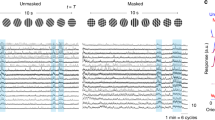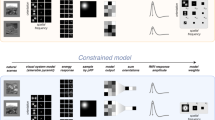Abstract
THE ability to detect or resolve a target consisting of a briefly presented bar or grating is diminished by preceding or following it with a grating of similar orientation. This orientation-specific masking is maximal when target and mask have the same orientation and the impairing effect of the mask decreases monotonically with increases in the angular difference between target and mask, reaching half its peak value at a difference of about ±15° (refs. 1–4). These findings have generally been attributed to the properties of single cortical cells which seem to act as orientation analysers and which have been shown to possess similar angular bandwidth tuning5–7. Such selective masking may be used to compile pattern feature lists and to elucidate their organization in the recognition of complex patterns8. But we know of no studies of selective masking of multi-attribute patterns. Accordingly, we have explored the feasibility of selectively masking orientational features of letters to produce predictable confusions in a typical pattern recognition task.
This is a preview of subscription content, access via your institution
Access options
Subscribe to this journal
Receive 51 print issues and online access
$199.00 per year
only $3.90 per issue
Buy this article
- Purchase on Springer Link
- Instant access to full article PDF
Prices may be subject to local taxes which are calculated during checkout
Similar content being viewed by others
References
Sekuler, R. W., J. Exp. Psychol., 70, 401 (1965).
Houlihan, K., and Sekuler, R. W., J. Exp. Psychol., 77, 281 (1968).
Campbell, F. W., and Kulikowski, J. J., J. Physiol., 187, 437 (1966).
Gilinsky, A. S., and Doherty, R. S., Science, 164, 454 (1969).
Hubel, D. H., and Wiesel, T. N., J. Physiol., 160, 106 (1962).
Hubel, D. H., and Wiesel, T. N., J. Neurophysiol., 28, 229 (1965).
Campbell, F. W., Cleland, B. G., Cooper, G. F., and Enroth-Kugell, Christina, J. Physiol., 198, 237 (1968).
Weisstein, Naomi, Psychol. Bull., 72, 157 (1969).
Campbell, F. W., and Maffei, L., J. Physiol., 207, 635 (1970).
Pantle, A., and Sekuler, R. W., Science, 162, 1146 (1968).
Author information
Authors and Affiliations
Rights and permissions
About this article
Cite this article
HENDERSON, L., COLES, S., MANHEIM, M. et al. Orientation-specific Masking of Letter Features. Nature 233, 498–499 (1971). https://doi.org/10.1038/233498a0
Received:
Revised:
Issue Date:
DOI: https://doi.org/10.1038/233498a0
This article is cited by
-
The effect of a masked stimulus on the response to the masking stimulus
Psychological Research (1995)
-
Integration, interruption and processing rate in visual backward masking
Psychologische Forschung (1973)
Comments
By submitting a comment you agree to abide by our Terms and Community Guidelines. If you find something abusive or that does not comply with our terms or guidelines please flag it as inappropriate.



